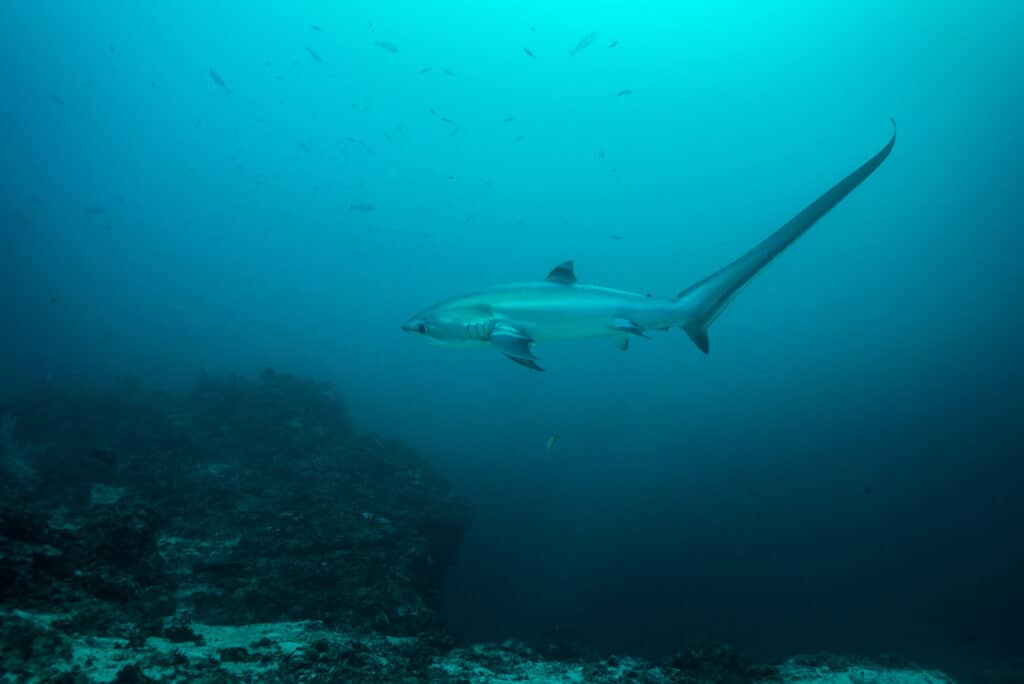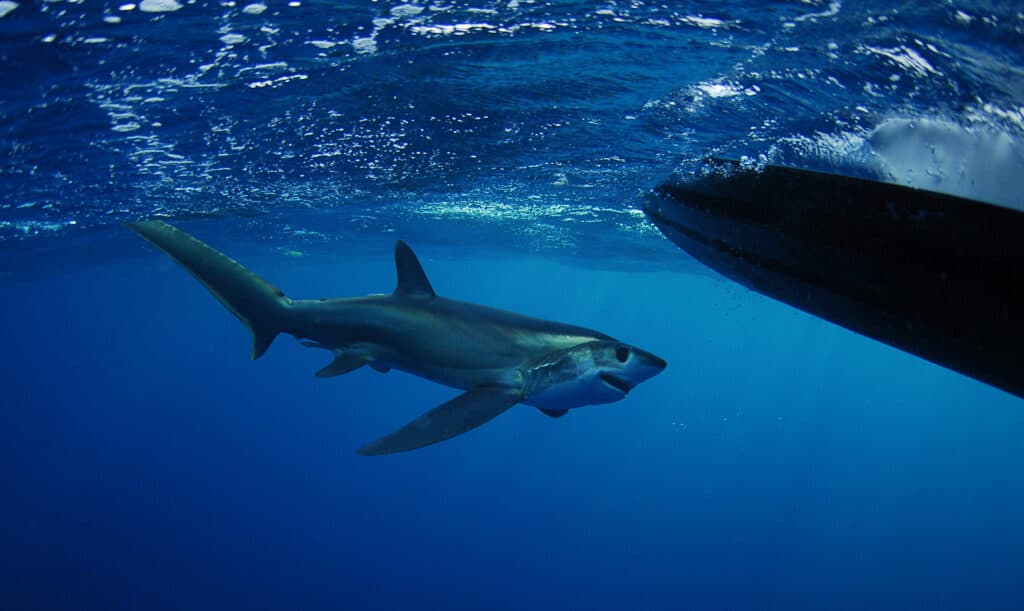Key Points:
- Thresher sharks are some of the largest sharks in our oceans and are popular targets for sports fishing in Florida, California, and South Africa.
- Adult threshers can reach lengths of over 20 feet, with half their total length coming from their incredibly long tail. The biggest thresher ever reliably measured was 32 feet long.
- The largest thresher shark ever caught off Florida weighed 544 pounds and 8 ounces, with an unknown length, in 1984 off of Destin. More recently, in 2011, a Florida fisherman hauled in a 650-pound, 13.5-foot-long thresher shark near Dania Beach.
Thresher sharks are nature’s oceanic speeding bullets. Known historically as fox sharks, these incredible fish can swim very fast in the ocean. Their long tails make them highly distinctive and give them an edge when it comes to hunting schools of fish. Thresher sharks are currently listed as Vulnerable, and, like all shark species, their numbers have decreased drastically in recent decades. Here, we’ll discover the largest thresher shark ever caught off Florida, as well as the largest thresher ever recorded.
Read on to learn all about thresher sharks, what they eat, where they live, and whether or not they’re dangerous to humans. We’ll discover just how big these incredible fish grow and what you can do to help preserve them for future generations.
Thresher Shark: Profile

There are three extant (living) species of thresher shark.
©bearacreative/Shutterstock.com
Thresher sharks are some of the largest sharks living in our oceans today. They live in many parts of the world and are popular targets for sports fishermen in places like Florida, California, and South Africa. They’re built for speed and make extremely effective hunters for schools of fish, specifically using their tails. The largest thresher shark ever caught off Florida is no small fry, but it’s still not the largest thresher ever recorded.
Let’s find out more about the fascinating thresher shark!
How Big Do Thresher Sharks Get?
Thresher sharks start out life already measuring over three feet long. Pups emerge from the mother’s womb in litters of 2-6 and grow rapidly from the moment of birth. Thresher sharks don’t reach sexual maturity until they’re around eight years old. By that time, they generally measure at least eight feet long. Adult threshers can reach lengths of over 20 feet. Of course, half their total length comes from their incredibly long tail.
Are There Thresher Sharks in Florida?

There are thresher sharks living in oceans in Florida.
©Shane Gross/Shutterstock.com
Unlike dusky sharks, lemon sharks, and leopard sharks, thresher sharks don’t live near the shore. Juvenile threshers are occasionally spotted in protected inlets and estuaries, but adults stick to the open ocean. The largest thresher shark ever caught off Florida was caught just off the continental shelf drop off the coast of Florida. Thresher sharks live in warm waters all over the world; they’re not deep divers like sperm whales, though.
So, you’re not likely to see a thresher shark while surfing, wading, swimming, or paddleboarding. But, chartered boat trips out to the open ocean might give you a glimpse of the incredible thresher. If you’re very lucky, you might see one breach fully out of the water as it hunts.
What Do Thresher Sharks Eat?
Thresher sharks are especially adapted to hunt schools of fish in the open ocean. A few of their favorite prey items include mackerel, small tuna, bluefish, and even seabirds floating on the water’s surface. To hunt, threshers swim rapidly into the thick of a school of fish. Then, they use their long tails to whip, stunning as many fish as they can with the concussive force of their tail. Once the fish are stunned, all they have to do is sweep through and suck them up.
The Largest Thresher Shark Ever Caught Off Florida

The largest thresher shark ever caught off Florida weighed 544 lbs!
©bearacreative/Shutterstock.com
The largest thresher shark ever caught off Florida was killed in 1984 off of Destin. It weighed 544 lb 8 ounces, with an unknown length. More recently, in 2011, a Florida fisherman hauled in a 650-pound, 13.5-foot-long thresher shark near Dania Beach. Thresher sharks don’t often come close to shore, and this one was caught several miles offshore.
What Is the Biggest Thresher Shark Ever Caught?
20-foot-long thresher sharks are not unheard of. But can thresher sharks grow even bigger than the largest thresher shark ever caught off Florida? They can! In fact, the largest thresher ever reliably measured was 32 feet long, that’s longer than the largest great white shark ever recorded!
Threshers might be big, but are they a threat to humans? Let’s find out!
Has a Thresher Shark Ever Attacked a Human?

Thresher sharks are not dangerous to humans.
©FtLaud/Shutterstock.com
According to Florida Musem’s International Shark Attack File (ISAF), there has never been a recorded instance of a thresher shark attacking a human. Thresher sharks don’t frequent the coastal areas that humans recreate, and they’re known to be shy and evasive when approached by people out at sea. When it comes to attacks on humans, the so-called big three species are tiger sharks, bull sharks, and great whites. So, while you likely won’t get the chance to swim with thresher sharks, you also don’t have to worry about one biting you.
Are Thresher Sharks Endangered?
Globally, shark populations have dipped by over 90% in recent decades. Thresher sharks are not immune to this depredation and are now listed as Vulnerable to extinction. Their primary threats are death as bycatch (unintentional entanglement in fishing lines and nets), overfishing, pollution, and the shark fin soup industry. Unfortunately, millions of sharks are still killed every year, and if things don’t change soon, they’ll soon disappear from our oceans altogether.
To help sharks, you can educate yourself about their vital role as apex predators in the food web. Use fewer plastics, especially single-use plastics, and choose sustainable seafood options. Shark conservation is key to protecting our oceans for future generations.
The photo featured at the top of this post is © HikeAndShoot/Shutterstock.com
Thank you for reading! Have some feedback for us? Contact the AZ Animals editorial team.







